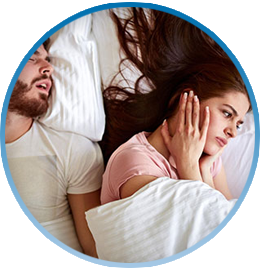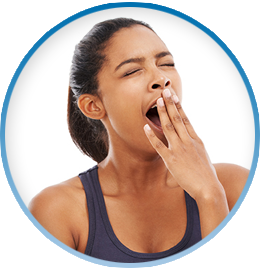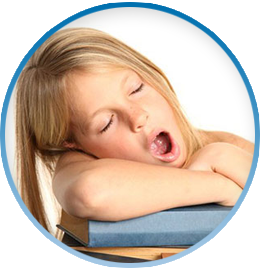Snoring

Disturbed breathing and disturbed sleep go hand in hand. It’s difficult to snore when you are breathing normally (slowly) and gently through the nose. The faster the air moves through the airways, the more turbulent is the airflow, and there is also a drop in air pressure. The snoring noise may result from the vibration of respiratory structures due to air movement during breathing while sleeping. In some cases, the sound may be soft, in other cases it can be loud and unpleasant.
Snoring during sleep may be a sign, or first alarm, of obstructive sleep apnoea (OSA). Research suggests that snoring is one of the factors of sleep deprivation. Snoring can be reduced with the BIM when the client learns to breathe more gently and smoothly while awake, which leads to a change in the habitual breathing pattern during wakefulness as well as while asleep.
Sleep Apnoea
Sleep apnoea is a condition characterised by stopping breathing for more than 10 seconds at a time while asleep, together with reduction in blood oxygen levels. Sleep apnoea is usually diagnosed by a polysomnograph or ‘sleep study’.
Risk factors for sleep apnoea include:
- Small or recessive jaws
- Being overweight which can narrow the airway
- Sleeping on the back which opens up the mouth and lets the lower jaw fall back to block the airway
Persons with sleep apnoea may display:
- Apnoeas of between 10 seconds and 2 minutes or more
- Snoring (though not always)
- Restlessness, excessive movement/ kicking while asleep (restless legs)
- Mouth breathing
- Dry mouth/throat on waking
- Thirst overnight and/or on waking
- Waking unrefreshed, daytime tiredness, foggy thinking
- Tendency to fall asleep in meetings and in front of the TV
- Breathlessness when exercising

Normal sleep occurs in five stages: Stages 1, 2, 3, 4 & REM (rapid eye movement). Stages 3 & 4 are the most restful and deep sleep. But when a person’s breathing is disordered, they may be prevented from easily reaching these stages and primarily remain in the light and easily disturbed sleep of stages 1 & 2. A person with sleep apnoea has the added difficulty of ‘arousal’ occurring each time an apnoea finishes with a gasping/snorting inhale which drags the person near to consciousness though often they remain asleep. This explains why it often takes a long time for a person to accept that they have a problem needing investigation.
Disturbed breathing and disturbed sleep go hand-in-hand. Signs of disturbed breathing patterns may be seen in people with sleep apnoea both when they are awake and when they are asleep.
Signs and symptoms of disordered day time breathing include:
- mouth breathing
- fast and or heavy breathing
- excessive yawning
- frequent sighing
- erratic or irregular breathing
- predominantly upper chest breathing pattern.
Disordered day time breathing can lead to sleep disordered breathing.
The Buteyko Institute Method (BIM) of breathing retraining addresses dysfunctional breathing habits through breathing retraining exercises and through education and awareness of posture, sleeping positions and lifestyle behaviours that influence breathing. The BIM teaches people to recognise their incorrect breathing patterns/habits, and how to improve their breathing, which may assist with improving sleep patterns.
Other Sleep Disturbances
 Sleeping disturbances may take many forms:
Sleeping disturbances may take many forms:
- insomnia
- waking throughout the night
- waking to go to the toilet in the night
- night terrors
- snoring
- apnoeas (where the breathing momentarily stops)
- waking feeling unrefreshed
- daytime tiredness
- bed-wetting.
The way that you are breathing may be affecting your sleep.
Hyperventilation / over-breathing, or ‘dysfunctional / disordered’ breathing may be implicated in all of the above situations.
Normal sleep is divided into five stages: Stage 1, Stage 2, Stage 3, Stage 4 and Rapid Eye Movement (REM). When we are chronically or habitually over breathing, or intermittently breathe dysfunctionally, our normal sleep patterns may become disturbed. Our bodies may primarily remain in Stages 1 & 2 – the lighter easily disturbed sleep, and it is difficult for the body to enter the deeper more restful Stages 3 & 4. The REM sleep achieved may become fragmented – the dreams that occur during this time tend to be vivid and chaotic.
Stages 3 & 4 sleep are important to the body for optimum functioning. For example, this is thought to be the time when many of the hormones and other chemicals produced by the body for everyday life are made. One of these hormones is ADH (Anti-Diuretic Hormone), which enables the body to concentrate the urine. People with sleep disordered breathing may often need to void urine more frequently than others and experience broken sleep due to nocturnal visits to the bathroom.
The Buteyko Institute Method of breathing retraining aims to normalise both daytime and night-time breathing. Improved sleep patterns are observed in many people.



